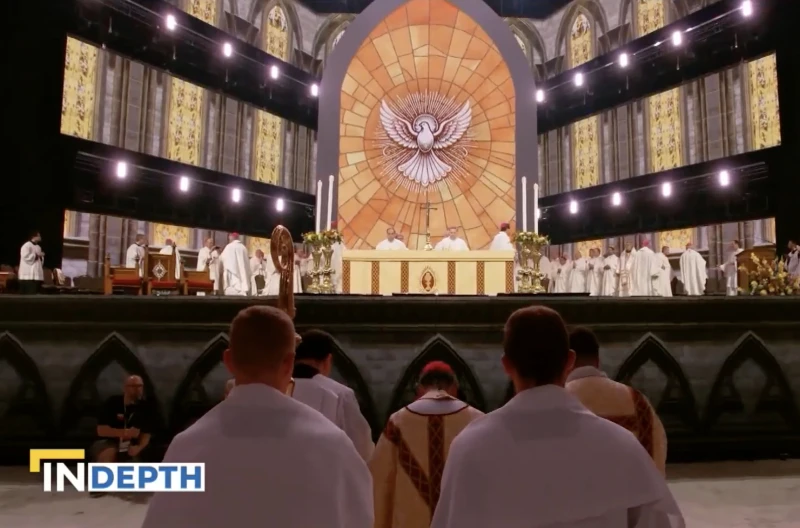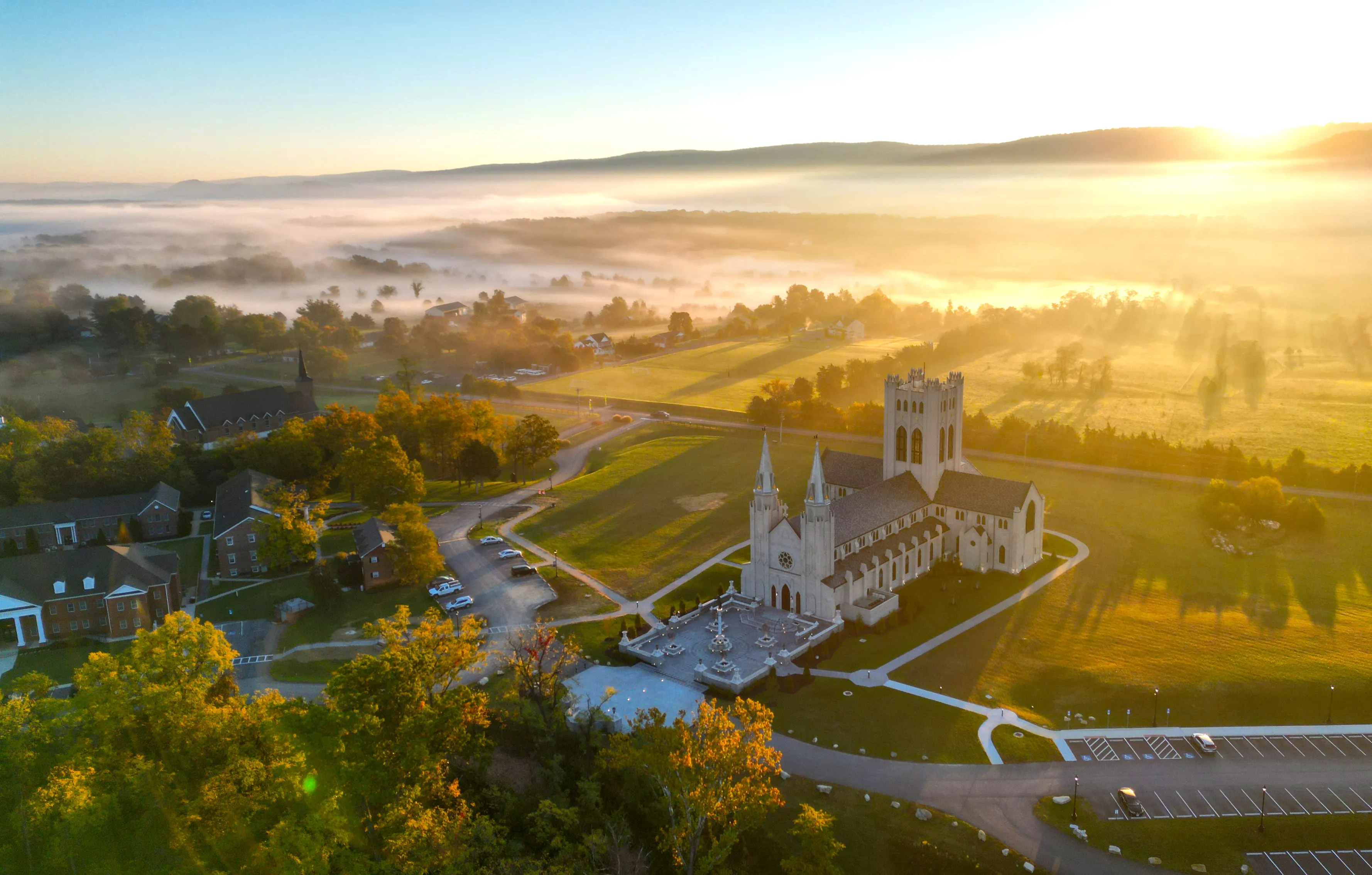

Scene from the 2024 National Eucharistic Congress in Indianapolis, Indiana. / Credit: EWTN News in Depth/Screenshot
Washington, D.C. Newsroom, Oct 18, 2025 / 12:00 pm (CNA).
Several hymns were temporarily banned last year in the Diocese of Jefferson City, Missouri after being found “to be insufficient in sound doctrine,” with the action raising questions about what music is allowed at the Holy Mass.
In a special report for the Oct. 17, 2025 edition of “EWTN News In Depth,” correspondent Mark Irons explored the subject. Archbishop Shawn McKnight, who implemented the brief ban, told Irons: “I would hope everybody else learns from my mistake.”
McKnight, who was the bishop of Jefferson City at the time, now serves as the archbishop of Kansas City. The controversial ban in question encompassed 12 songs in total, including the popular hymns “I am the Bread of Life” and “All Are Welcome.”
McKnight said the decree was implemented too quickly and without enough discussion among Catholics in the diocese.
Currently, no particular hymns are excluded in the Diocese of Jefferson City, but parishes are required to evaluate Mass music using guidelines that were provided for archdioceses and dioceses across the nation by the U.S. Conference of Catholic Bishops (USCCB).
The USCCB’s 2020 “Catholic Hymnody at the Service of the Church: An Aid for Evaluating Hymn Lyrics” was created to make sure Mass hymns are in conformity with Catholic doctrine. The bishops list a number of specific concerns regarding hymns, including ones with “deficiencies in the presentation of Eucharistic doctrine,” those “with a view of the Church that sees Her as essentially a human construction,” or songs with “an inadequate sense of a distinctively Christian anthropology.”
Kevin Callahan, who serves as the music director at Sacred Heart Parish in Glyndon, Maryland, told Irons: “We believe…the body and blood, soul and divinity of Christ is here at the Mass, in the Eucharist. The songs, of course, should reflect that.”
Callhan explained that he understands why the bishops would create the aid. The bishops “want the right thing to be said in Church, they don’t want the wrong idea to get tossed around.” Callahan said he does believe there are certain hymns that could be misleading.
The ‘pride of place” of Gregorian chant
Over time, Callahan said, Gregorian chant has earned pride of place within the liturgy of the Mass.
This was reflected in the Second Vatican Council document Sacrosanctum Concilium, which explains: “The Church acknowledges Gregorian chant as specially suited to the Roman liturgy.”
Sara Pecknold, a professor of liturgical music at Christendom College, noted that “Gregorian chant, beyond a shadow of a doubt, was developed with and for the liturgy.”
“The Second Vatican council teaches us that the more closely tied the music is to the liturgical action…the more sacred it is,” she pointed out.
Recommendations
If Gregorian chant is unfamiliar to a parish, Pecknold recommends small steps that could be taken. She said: “I would first start with the very simplest chant melodies, for the ordinaries of the Mass.”
Beyond Gregorian chant, the Second Vatican Council decided that the Church approves “of all forms of true art having the needed qualities, and admits them into divine worship.”
Pecknold explained: “Liturgical music should glorify God and it should sanctify and edify all of us who are present at this great sacrifice.”
Welcoming a diversity of styles
Dave Moore, the music director at the 2024 U.S. National Eucharistic Congress, was in charge of bringing together a wide variety of Catholic musicians from across the country for the event.
Moore said the musical goal of the Congress was to create a unity rooted in Christ, through different styles of music.
“I don’t know how you find unity without diversity,” Moore said. “There’s a lot of people who do things differently than we’re used to, but what we’re looking for is the heart, like are you pursuing the heart of God?”
Archbishop McKnight also noted the need for variety.
“Catholicity means there’s a universality to who we are, that we’re not of just one kind or one culture, but there’s a diversity of charisms and a diversity of styles,” he said. “The fact that there are different ways of entering into the mystery of Christ, actually increases the unity we have, otherwise we’re just a church of some, and not the Church of all.”
Music is “often associated with memories and emotions, too,” he said. “That’s a part of our celebration of the Eucharist. It’s not just a thing of the mind. It’s not just a doctrinal assent. It’s also a movement of the heart and ultimately it’s active prayer.”
“Hymns that are liked by the people are a good choice, but it’s also important that they convey the Catholic faith,” McKnight said. “It’s about discernment of the will of God and what the Holy Spirit wants.”
Read More![Judge rules against saints’ statues on Massachusetts government building #Catholic
Statues of St. Florian (at left) and St. Michael the Archangel (at right) are currently barred from appearing on the planned public safety building of Quincy, Massachusetts. / Credit: Courtesy of Office of Mayor Thomas Koch
Boston, Massachusetts, Oct 16, 2025 / 12:18 pm (CNA).
A Massachusetts trial court judge has issued an order blocking the installation of statues of two Catholic saints on a new public safety building in the city of Quincy, setting up a likely appeal that may determine how the state treats separation of church and state disputes going forward.The 10-foot-high bronze statues of St. Michael the Archangel and St. Florian, which were scheduled to be installed on the building’s façade this month, will instead await a higher court’s decision.The statues cost an estimated $850,000, part of the new, $175 million public safety building that will serve as police headquarters and administration offices for the Boston suburb’s fire department.Quincy Mayor Thomas Koch, a practicing Catholic, has said he chose St. Michael the Archangel because he is the patron of police officers and St. Florian because he is the patron of firefighters, not to send a message about religion.But the judge said the statues can’t be separated from the saints’ Catholic connections.“The complaint here plausibly alleges that the statues at issue convey a message endorsing one religion over others,” Norfolk County Superior Court Judge William Sullivan wrote in a 26-page ruling Oct. 14.The judge noted that the statues “represent two Catholic saints.”“The statues, particularly when considered together, patently endorse Catholic beliefs,” the judge wrote.The plaintiffs who brought the lawsuit challenging the statues — 15 city residents represented by the American Civil Liberties Union of Massachusetts — have amassed facts that “plausibly suggest that an objective observer would view these statues on the façade of the public safety building as primarily endorsing Catholicism/Christianity and conveying a distinctly religious message,” the judge wrote.Rachel Davidson, staff attorney at the ACLU of Massachusetts, who argued the case during a lengthy court hearing on Sept. 19, praised the judge’s decision.“This ruling affirms the bedrock principle that our government cannot favor one religion above others, or religious beliefs over nonreligious beliefs,” Davidson said in a written statement. “We are grateful to the court for acknowledging the immediate harm that the installation of these statues would cause and for ensuring that Quincy residents can continue to make their case for the proper separation of church and state, as the Massachusetts Constitution requires.”The mayor said the city will appeal.“We chose the statues of Michael and Florian to honor Quincy’s first responders, not to promote any religion,” Koch said in a written statement provided to the National Catholic Register, CNA’s sister news partner, by a spokesman. “These figures are recognized symbols of courage and sacrifice in police and fire communities across the world. We will appeal this ruling so our city can continue to celebrate and inspire the men and women who protect us.” The lawsuit, which was filed May 27 in Norfolk County Superior Court in Dedham, relies on the Massachusetts Constitution, not the U.S. Constitution, but there is a tie-in.In 1979, the Massachusetts Supreme Judicial Court adopted the U.S. Supreme Court’s 1971 three-pronged “Lemon test” when considering church and state cases — whether a law concerning religion has “a secular legislative purpose,” whether “its principal or primary effect … neither advances [n]or inhibits religion,” and whether it fosters “excessive entanglement between government and religion.” The state’s highest court also added a fourth standard — whether a “challenged practice” has “divisive political potential.”But in June 2022, the U.S. Supreme Court ditched the Lemon test in Kennedy v. Bremerton School District, a case involving prayers offered by a high school football coach in Washington state.If the Massachusetts Supreme Judicial Court, which is the ultimate interpreter of state law, takes the Quincy statues dispute, it would be the first time the court has considered a case on point since the U.S. Supreme Court’s Kennedy decision.This story was first published by the National Catholic Register, CNA’s sister news partner, and has been adapted by CNA.](https://unitedyam.com/wp-content/uploads/2025/10/judge-rules-against-saints-statues-on-massachusetts-government-building-catholic-statues-of-st-florian-at-left-and-st-michael-the-archangel-at-right-are-currently-barred-from-appea.webp)





